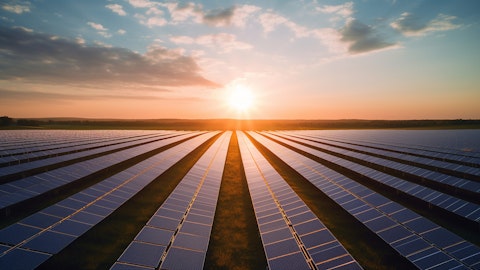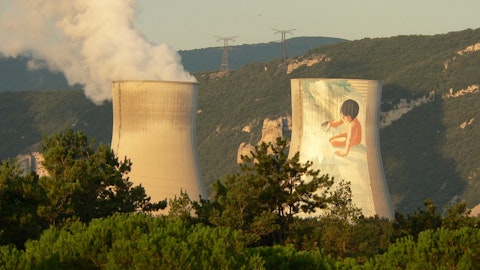Lynn Good: Yeah. Thank you, Julien. I’m going to turn to Brian to discuss it.
Brian Savoy: Yeah. Good morning, Julien. So, when we look at 2024, the setup on load growth is really underpinned by three main points. So you start with economic development visibility we have in 2024 projects that are in late-stage construction that are coming online. And we’ve got that on one of our slides. And that represents a little under a 1% growth as we look into 2024. On the residential side of things, we’ve seen this normalization coming out of COVID of return to the office, right? During COVID, we had a lot of residential usage at homes. As return to the office, you saw this kind of lower usage at homes, more in commercial businesses. And the back part of 2023, we saw that level out. So we will start growing residential more in line with customer migration trends, which has been really strong 1.7%, 1.8% in recent years.
And so residential growth, we expect to be on an upward trajectory. And then lastly, the existing C&I customers where we saw a reduction in load in 2023 and when we talked about it throughout the year. Those customers are very optimistic in 2024. They’ve kind of seen a rebound happening maybe mid-ish year. So those three factors give us confidence that 2% load growth in 2024 is definitely in our sights.
Lynn Good : And over the long term, Julien, all of the things that Brian talked about we’re going to continue to experience customer migration. Our existing customer base continues to demonstrate some strength over the five-year period. So probably the most new or significant driver is this economic development load. And we’ve given you a range of what we’re seeing, and what we’ve put on the slide are the things that we believe have a high degree of confidence of being achieved. So DRIP is moving, letters of agreement have been signed and we’re moving forward. And so the combination of our existing base population migration and the strong economic development gave us confidence to raise the long-term growth rate.
Julien Dumoulin-Smith: Got it. Excellent. So it sounds like things have reaccelerated here even just quarter-over-quarter even just on the margin?
Lynn Good: Well, and I think Julien, we were continuing to grapple with this economic development all through 2023 and came to our filing here in the Carolinas in January, really reckoning with where we think this is going. So we have continued to mature our own thinking, working with our customers, working with the prospects coming to the area and believe this represents a really solid range. And when we’re looking at that range, the growth is going to come along with it on megawatt hours and that’s what you’re seeing in our update.
Julien Dumoulin-Smith: Great. Thank you guys. See you soon.
Lynn Good: Thank you.
Operator: Our next question comes from Steve Fleishman of Wolfe Research. Please go ahead.
Steve Fleishman: Thank you.
Brian Savoy: Good morning, Steve.
Lynn Good: Hi, Steve.
Steve Fleishman: Good morning, Lynn and Brian. Just one more on the nuclear PTC. The — any sense on when we’re actually going to get details from the treasury and setting it any update there?
Brian Savoy: Steve, our best intel is the first half of the year. So we’re thinking kind of sometime in Q2 we would get the final guidance from treasury and I think that’s the general consensus.
Steve Fleishman: Okay. And obviously you need that to then go do the monetization I assume?
Brian Savoy: Sure. Sure.
Steve Fleishman: Yeah. Okay. On the financing the equity plan, the DRIP and ATM, any kind of color on how much of that can be done through DRIP relative to ATM?
Lynn Good: Yeah. So Steve you should think about DRIP as being about $200 million a year. It’s about 40% of it.
Steve Fleishman: Yeah. And then just on the gas plant filing in the Carolinas what — when would these — when would you be roughly targeting for these plants to come online?
Lynn Good: So 2028, 2029 Steve. Combined cycle plants two and 2028 — or I’m sorry CTs two and 2028 CCs one and 2028 one and 2029.
Steve Fleishman: Okay. But obviously some of the capital would be hitting in AFDC hitting within the end of your?
Lynn Good: Yeah. You start to see it. The largest capital spend is in the last couple of years is construction as you know from history on these. But you’ll see us beginning to ramp up well within this five-year period.
Steve Fleishman: Okay, great. That’s it from me. Thank you.
Lynn Good: All right. Thank you, Steve.
Operator: Our next question comes from David Arcaro of Morgan Stanley. Please go ahead, your line is open.
Lynn Good: Hi David.
David Arcaro: As we think about the 1.5% to 2% load growth I was just curious is that concentrated in certain service territories more than others? Are you seeing certain states growing faster versus others in your footprint?
Brian Savoy: David I would think about the Carolinas has seen the largest portion of the economic development prospects we see. But we do see healthy growth across our jurisdictions. I mean Indiana with this restoring of manufacturing has really seen economic development growing. Florida continues to grow in a really strong way in 2% customer migration trends as well as the commercial businesses that support it. So, I would say Carolinas is slightly ahead of the others but all of really good growth.
David Arcaro: Okay, got it. Not several percentage points faster in any specific state, but fairly tightly grouped around there?
Lynn Good: Yes. And David I would say building on what Brian said residential growth has been stronger in the Carolinas and Florida. Commercial and Industrial in the Midwest has been good and it’s also been good in the Carolinas. So, the growth kind of varies by customer class but I would go back to where I commented a moment ago we have a wealth of opportunities. And these are not only good for Duke Energy’s growth but they’re good for our states. It’s capital investment it’s job creation supply chain is coming with a lot of these manufacturers. So it’s good for the service territories that we are serving.





